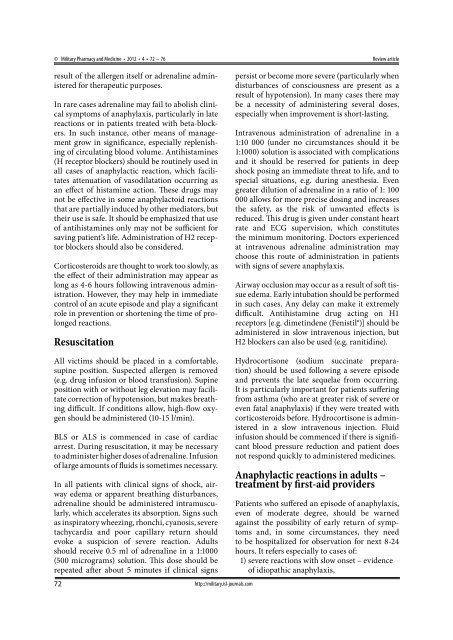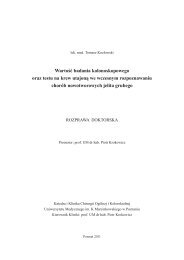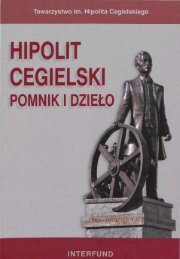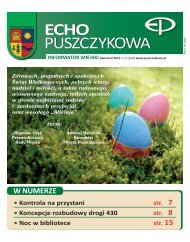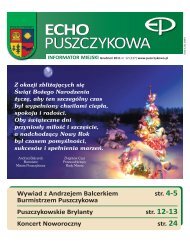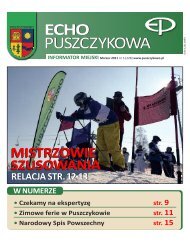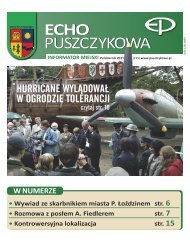MILITARY PHARMACY AND MEDICINE
MILITARY PHARMACY AND MEDICINE
MILITARY PHARMACY AND MEDICINE
You also want an ePaper? Increase the reach of your titles
YUMPU automatically turns print PDFs into web optimized ePapers that Google loves.
© Military Pharmacy and Medicine • 2012 • 4 • 72 – 76result of the allergen itself or adrenaline administeredfor therapeutic purposes.In rare cases adrenaline may fail to abolish clinicalsymptoms of anaphylaxis, particularly in latereactions or in patients treated with beta-blockers.In such instance, other means of managementgrow in significance, especially replenishingof circulating blood volume. Antihistamines(H receptor blockers) should be routinely used inall cases of anaphylactic reaction, which facilitatesattenuation of vasodilatation occurring asan effect of histamine action. These drugs maynot be effective in some anaphylactoid reactionsthat are partially induced by other mediators, buttheir use is safe. It should be emphasized that useof antihistamines only may not be sufficient forsaving patient’s life. Administration of H2 receptorblockers should also be considered.Corticosteroids are thought to work too slowly, asthe effect of their administration may appear aslong as 4-6 hours following intravenous administration.However, they may help in immediatecontrol of an acute episode and play a significantrole in prevention or shortening the time of prolongedreactions.ResuscitationAll victims should be placed in a comfortable,supine position. Suspected allergen is removed(e.g. drug infusion or blood transfusion). Supineposition with or without leg elevation may facilitatecorrection of hypotension, but makes breathingdifficult. If conditions allow, high-flow oxygenshould be administered (10-15 l/min).BLS or ALS is commenced in case of cardiacarrest. During resuscitation, it may be necessaryto administer higher doses of adrenaline. Infusionof large amounts of fluids is sometimes necessary.In all patients with clinical signs of shock, airwayedema or apparent breathing disturbances,adrenaline should be administered intramuscularly,which accelerates its absorption. Signs suchas inspiratory wheezing, rhonchi, cyanosis, severetachycardia and poor capillary return shouldevoke a suspicion of severe reaction. Adultsshould receive 0.5 ml of adrenaline in a 1:1000(500 micrograms) solution. This dose should berepeated after about 5 minutes if clinical signsReview articlepersist or become more severe (particularly whendisturbances of consciousness are present as aresult of hypotension). In many cases there maybe a necessity of administering several doses,especially when improvement is short-lasting.Intravenous administration of adrenaline in a1:10 000 (under no circumstances should it be1:1000) solution is associated with complicationsand it should be reserved for patients in deepshock posing an immediate threat to life, and tospecial situations, e.g. during anesthesia. Evengreater dilution of adrenaline in a ratio of 1: 100000 allows for more precise dosing and increasesthe safety, as the risk of unwanted effects isreduced. This drug is given under constant heartrate and ECG supervision, which constitutesthe minimum monitoring. Doctors experiencedat intravenous adrenaline administration maychoose this route of administration in patientswith signs of severe anaphylaxis.Airway occlusion may occur as a result of soft tissueedema. Early intubation should be performedin such cases. Any delay can make it extremelydifficult. Antihistamine drug acting on H1receptors [e.g. dimetindene (Fenistil®)] should beadministered in slow intravenous injection, butH2 blockers can also be used (e.g. ranitidine).Hydrocortisone (sodium succinate preparation)should be used following a severe episodeand prevents the late sequelae from occurring.It is particularly important for patients sufferingfrom asthma (who are at greater risk of severe oreven fatal anaphylaxis) if they were treated withcorticosteroids before. Hydrocortisone is administeredin a slow intravenous injection. Fluidinfusion should be commenced if there is significantblood pressure reduction and patient doesnot respond quickly to administered medicines.Anaphylactic reactions in adults –treatment by first-aid providersPatients who suffered an episode of anaphylaxis,even of moderate degree, should be warnedagainst the possibility of early return of symptomsand, in some circumstances, they needto be hospitalized for observation for next 8-24hours. It refers especially to cases of:1) severe reactions with slow onset – evidenceof idiopathic anaphylaxis,72 http://military.isl-journals.com


